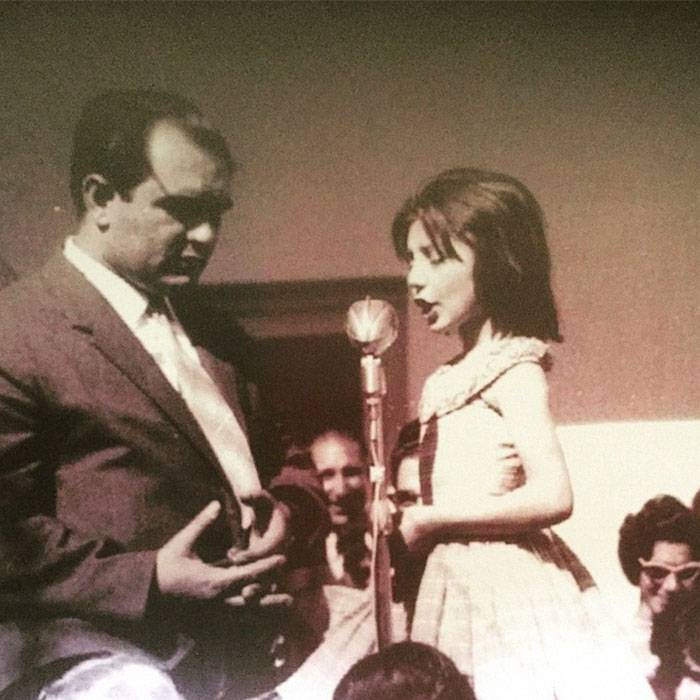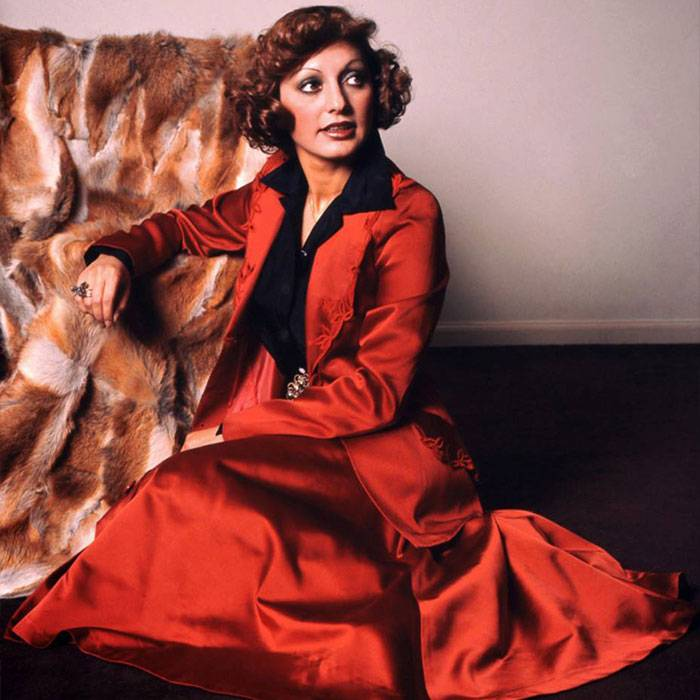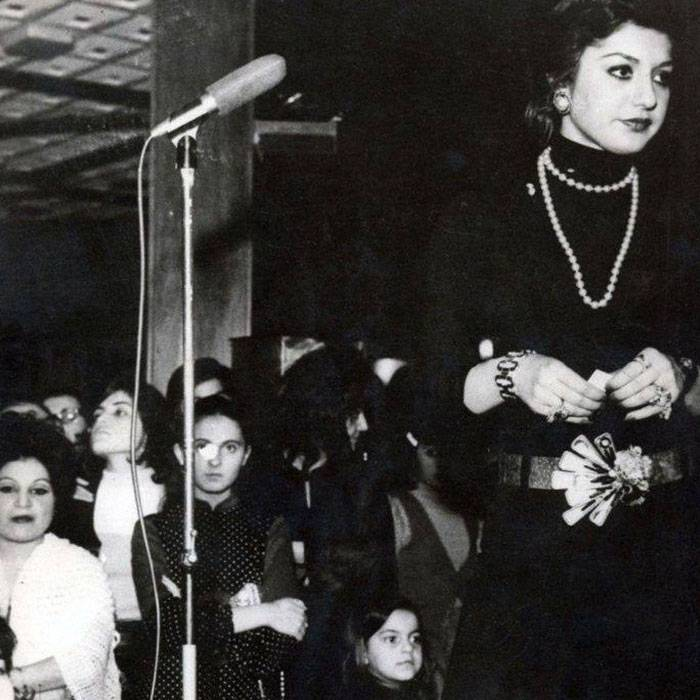Kokosh, the lyrical legend of Iran

In the "Crystal Palace" cafe in Tehran in the mid-1950s, Iranian comedian and acrobatic player Saber Atashin was scheduled to present his nightly show to the public. The artist felt a burning heart that necessitated his immediate transfer to the hospital, and his scheduled paragraph for the public remained empty. The owner of the café remembered the artist's daughter, Faika, a five-year-old girl, and how she used to accompany her father, imitating some of the songs and movements he was doing. Go to her room and wake her up to save the situation. He took her with him to the theater to present what she used to do as a hobby in the past, as she performs a segment of the entertainment program for the audience, while she is standing on a chair for people to see. That night was the artistic breakthrough for Kokosh, who has not left the stage nor fame until now.
Kokosh was born in Tehran in 1950 to Azerbaijani parents, and at an early age her parents divorced. Kokosh lost her mother and continued to live with her father, who discovered her talent from a young age, taking care of her training and teaching her to sing and dance.

Kokosh with her father
After she gave her first show on the night her father fell ill, the talented girl became more and more famous day by day, and people started flocking to watch her sing on stage, which raised her wages to a level higher than her father's. At the age of eight, Kokosh appeared in her first film entitled "Hope and Fear", then her films continued to reach 25 films, the last of which was in 1978.
This early start to her artistic activity from childhood prevented Kokosh from completing her school education, but the education she received from other teachers made up for her traditional education. Iranian composers have rallied around this rising talent, who has caught the eye with her sweet voice and outstanding performance, and the new spirit she has infused into artistic life and pop music in Iran.
The beautiful young singer has become the focus of attention of young men and women alike. Her beauty and overwhelming stage presence drew fans, and her modern clothes and hairstyles that were fashionable back then in the sixties and seventies were the model for the elegant, beautiful woman that all young women would like to emulate.

Kokosh's fame extended beyond Iran to Arab countries such as Iraq, where in the seventies her songs were broadcast on television and sold on cassette tapes in the markets, despite the language barrier, which confirms the depth of talent that does not recognize language barriers. Her songs also spread in many neighboring countries, such as Afghanistan and Pakistan, and among many Arab Gulf citizens of Iranian descent.
The 67-year-old Iranian pop queen Kokosh does not seem to have lost any of the sweetness, charisma and presence of her voice.
How can a government imprison a voice like that of Kokosh for two decades, and deprive the world of one of the most beautiful symbols of Iran in modern times?
Kokosh sang in many languages in addition to Persian, such as Arabic, English, French, Armenian and others. The lyrical colors she performed varied, from songs with a fast paced dance, to songs with an oriental spirit, as well as dreamy romantic songs close to the school of French singer Edith Piaf.
Due to the modernization it introduced to the musical taste in Iran by blending Western pop melodies with oriental performance spirit and lyrics, Kokosh became a symbol of modernity and the contemporary trend that the regime of Shah Mohammad Reza Pahlavi was seeking to spread. She became a favorite of the royal family and the imperial court and sang on several occasions in front of the Shah and his family.

When the revolution broke out against the Shah and his regime collapsed, Kokosh was in Los Angeles, but she decided to return out of homesickness. She was imprisoned after her return for a short period and was later released. After the declaration of the Islamic Republic, she was prevented from singing and had to stay at home from 1979 until 2000, when the Iranian government allowed her to leave the country. In July 2000, she started her first concert after an absence of more than two decades in Canada, where the audience of 15,000 greeted her with passionate, standing applause for 10 minutes, and she ended her artistic journey at that time with two concerts in Dubai.
Her concerts witnessed an unparalleled turnout, as if the twenty years had not affected her popularity, but rather increased her brilliance. And it seems that the taste of the overwhelming success achieved by Kokosh encouraged her to stay out of Iran and revived the star who had tied her voice to the government for two decades. Kokosh announced at the time that she would donate a portion of her concert revenue to poor children in Iran.

In 2009, after the so-called Green Revolution in Iran, Kokosh participated in a vigil in front of the United Nations headquarters to express her solidarity with the mothers of those who were shot dead by Iranian security forces at the time, and to demand the release of detainees in the demonstrations that followed the defeat of the reformist candidate Mir Hossein Mousavi in the presidential elections. . In the following years, Kokosh toured many countries attracting a wide audience, as she held concerts in Iraqi Kurdistan, the famous Albert Hall Theater in London, and the Nokia Theater in Los Angeles.
Since her return to singing, Kokosh has released seven albums, varying in colors between eastern songs and western rhythms. On her sixth album "E'jaz", Kokoush composed a poem by Jalal al-Din al-Rumi called "I and You Bi manoto", in which she was keen to give the poetic words of love a melody steeped in his spirituality and orientalism.
At the age of 67, the Iranian pop queen does not seem to have lost anything of the sweetness of her voice, her charisma, and her overwhelming presence on the stage.
More importantly, Kokosh's presence brings to life in front of people the image of modern, civilized Iran, which its sons boast about as the heirs of Persia's ancient history in literature and the arts.
Kokosh is the beautiful, liberated, talented Iranian woman as opposed to the woman covered in the chador and hijab imposed by the Islamic government after the revolution. Kokosh is the launch against the restrictions, the bright colors against the black robe, the loud voice against the naked voice.

Kokosh, who is still moving like a butterfly on the world's stages and between its capitals, is the best example for the artist when he turns into a symbol that expresses what is greater and deeper than just amusement or a beautiful voice.
https://raseef22.net/article/112837-%D9%83%D9%88%D9%83%D9%88%D8%B4%D8%8C-%D8%A3%D8%B3%D8%B7%D9%88%D8%B1%D8%A9-%D8%A5%D9%8A%D8%B1%D8%A7%D9%86-%D8%A7%D9%84%D8%BA%D9%86%D8%A7%D8%A6%D9%8A%D8%A9

